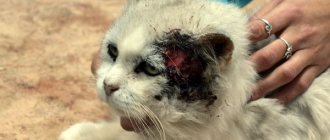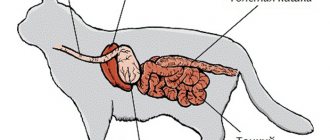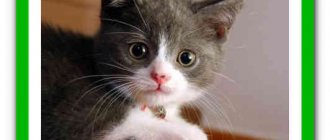How vaccination against panleukopenia works When a kitten is vaccinated against panleukopenia What vaccines against feline distemper are used Complications after vaccination Distemper is the colloquial name for one of the most dangerous infectious diseases for kittens - panleukopenia. The term “plague” itself is translated as “infection,” and nowadays it usually means any disease with a high probability of death and high contagiousness - that is, a high degree of contagiousness for healthy cats.
Feline panleukopenia (infectious parvovirus enteritis) is a viral disease. The virus is very stable in the external environment, highly contagious (an extremely small number of viral particles upon contact can cause infection); a very large part of the population of stray cats are carriers of this virus. The clinic often finds cats with panleukopenia that have never left the apartment or met other animals - the owner can bring the virus with them on their shoes along with street dirt. Vaccination of kittens and cats against distemper (we use this term in the article as it is more familiar to owners, but we explain the correct name of the disease) is the only reliable way to prevent this disease.
Antiviral complex
The general name of the disease includes parvovirus infection, panleukopenia, and infectious enteritis.
The pathogens are so persistent that they are spread not only by sick animals; you can become infected in utero, as well as through objects that have been in contact with an infected object. The causative agents of the disease are very resistant to environmental influences and are perfectly preserved in it. They easily tolerate disinfectants and exposure to high temperatures. It is noteworthy that a cat that has recovered from the disease receives immunity from this disease for the rest of its life. Vaccinating your kitten against distemper will help protect your pet from a dangerous infection.
https://www.youtube.com/watch?v=ytpress
The activation of virus pathogens occurs at the beginning of spring. With the onset of winter cold, the likelihood of infection decreases significantly. The asymptomatic period of the disease lasts from 2 to 10 days, and the acute form in cats lasts from one to ten days. Infection of a pet occurs through contact with an infected pet or microorganisms brought on outer clothing or objects, through infected blood, through the gastrointestinal tract, or by eating contaminated food.
The disease manifests itself very sharply in cats. The earlier the owner identifies the disease in the pet, the higher the likelihood of saving the kitten’s life. The main manifestations include:
- loss of appetite and refusal to drink;
- diarrhea and vomiting;
- the lethargic state of the cat and its attempt to hide in a dark place;
- twisted body position and convulsions;
- refusal to take care of yourself.
Very quickly, the animal becomes critically severely dehydrated. You can prevent your pet from suffering with timely distemper vaccinations for cats.
The general name of the disease includes parvovirus infection, panleukopenia, and infectious enteritis. The pathogens are so persistent that they are spread not only by sick animals; you can become infected in utero, as well as through objects that have been in contact with an infected object.
The causative agents of the disease are very resistant to environmental influences and are perfectly preserved in it. They easily tolerate disinfectants and exposure to high temperatures. It is noteworthy that a cat that has recovered from the disease receives immunity from this disease for the rest of its life. Vaccinating your kitten against distemper will help protect your pet from a dangerous infection.
Immunoglobulin serum. It affects the causative agent of panleukopenia in animals at any age, incl. during pregnancy and lactation. There are no contraindications or side effects. The product can be combined with any other medications. The drug is administered subcutaneously, twice per course (once a day) at the rate of 1 ml for a pet weighing up to 10 kg, 2 ml for an animal over 10 kg.
Injection solution based on pine needle extract. It is used simultaneously with other symptomatic remedies, which gives the best effect. Placed subcutaneously, dose calculation: 0.5 ml per 5 kg of weight, if the pet weighs less than 1 kg - 0.2 ml. Scheme:
- 1-2 days – 2 times;
- from 3 to 10 days – 3 times;
- from 11 to 13 days – 2 times;
- 14-15 days – 1 time.
Enterostat. 1 injection once weekly. For every kg of weight – 20 mg of the drug.
In addition, other therapeutic measures are carried out in parallel:
- hyperimmune serum - in the first few days of the disease;
- vitamin complex to strengthen the immune system;
- glucose intravenously or subcutaneously (5% solution) to maintain the body;
- corticosteroid drugs to relieve shock;
- salt solutions drip to relieve intoxication;
- antiemetic to prevent dehydration.
If there is a concomitant infection, then antibacterial drugs are used.
Stages of the disease
Drug therapy based on the symptoms of distemper in dogs begins no earlier than the end of the incubation period. It lasts from 3 days to 3 weeks and depends on the state of the infected person’s immune system. It is only possible to detect symptoms and begin treatment for distemper in dogs on the first day only in cases of severe immunodeficiency.
After entering the body, the virus spreads through the bloodstream to all vital systems, causing serious disruptions in the functioning of internal organs. Its reproduction occurs in immune cells and lymph nodes. Because of this, the infected organism's defense against bacterial and fungal diseases is reduced. Infection of the nervous system occurs in the second week.
The first symptoms of canine distemper in dogs occur 3-90 days after infection. Such a long incubation period greatly interferes with diagnosis. Deviations can only be recognized by lethargy or low appetite. Veterinarians recommend being vigilant and paying attention to any changes in your pet’s usual behavior.
How do people get sick?
There are many methods of transmission. Basically, the virus enters the cat’s body through airborne droplets. Also, transmission occurs through the feces of sick cats or dogs. This can happen if the cat has a dirty litter box and there was a previously infected cat in there. Also, through dirty dishes, food, shoes. Even fleas can carry plague.
A cat can be infected within a year, and will transmit the virus further to other animals. Kittens can already be infected from the age of 6-12 weeks. At this time, the protective system against the mother cat is just ending.
Transmission occurs from a pregnant cat to kittens. However, not all animals from the same litter can be sick with distemper. Some experienced symptoms of immobility, fever, and tremors. True, these signs will remain for life. Over time, the kitten gets used to it and leads a normal life.
Forms of the disease
Depending on the severity of the symptoms manifested and the speed of development, 4 forms of pathology are distinguished. The most favorable prognosis is typical for the subacute form.
Acute
The patient's temperature rises sharply to 41-42 °C and his appetite disappears. Convulsions and paralysis may occur. On the second or third day after infection, the animal falls into a coma and dies.
Subacute
Subacute distemper in dogs is the most common form of pathology. It is accompanied by classic symptoms and responds well to treatment. The main symptom of this form is remitting (with periods of weakening) fever. The temperature rises above normal and then returns to normal.
Lightning fast
Fulminant distemper in dogs is the most dangerous form, killing the infected person within 24 hours. Due to vague symptoms, it is very difficult to diagnose, so death occurs suddenly.
Chronic
This form is characterized by a series of remissions and relapses. It occurs as a consequence of an acute or subacute form and lasts several months. The occurrence of chronic distemper in a puppy is often associated with unsuccessful vaccination.
When and how is vaccination carried out?
At the moment, an experimentally obtained plague vaccine is used, which shows the highest effectiveness results. It is very important to properly prepare the cat for the upcoming procedure. To do this, you should show your pet to a veterinarian, because only an experienced specialist is able to ascertain the pet’s health condition and confirm the possibility of its vaccination. Then, 10 days before the expected date, you need to carry out anthelmintic treatment and get rid of fleas.
The kitten is first vaccinated at the age of 2-2.5 months. Repeated vaccination is carried out after 14-20 days. This will make the animal’s immunity strong, and subsequent injections will be carried out once a year. At the same time, you can get a rabies vaccination, which is also revaccinated annually.
We suggest you read: Heart disease in cats symptoms ⋆ Heart Treatment
It is definitely worth considering the option of a complex drug that allows you to vaccinate a kitten against several infectious diseases at once. Some vaccines are already comprehensive, so the kitten owner should consult a veterinarian when choosing a drug. It is worth carrying out the manipulation using the same drug.
After the manipulation, a 30-day quarantine period begins, during which the kitten must not contact other animals, and its owners should avoid visiting places where there are pets.
The vaccination is done at the withers of the animal. After the manipulation, the veterinarian enters the necessary information about vaccination into the animal’s passport, attaches the label from the ampoule with the vaccine there, and seals the entry made with a seal. These actions can make life much easier for the cat’s owners in the future, especially if the animal is often taken with them on trips and trips.
How much vaccination for kittens costs depends on the drug chosen for this, whether it is mono or complex. Of no small importance is the clinic where the owner is going to vaccinate the kitten or the cost of a doctor visiting the house. If the owner decides to carry out the manipulation himself, it will cost a little less.
At the moment, an experimentally obtained plague vaccine is used, which shows the highest effectiveness results. It is very important to properly prepare the cat for the upcoming procedure. To do this, you should show your pet to a veterinarian, because only an experienced specialist can determine the pet’s health condition and confirm the possibility of its vaccination. Then, 10 days before the expected date, you need to carry out anthelmintic treatment and get rid of fleas.
The kitten is first vaccinated at the age of 2-2.5 months. Repeated vaccination is carried out after 14-20 days. This will make the animal’s immunity strong, and subsequent injections will be carried out once a year. At the same time, you can get a rabies vaccination, which is also revaccinated annually.
What is the danger of panleukopenia or viral enteritis?
The causative agent of the disease is DNA-containing parvovirus. It is highly resistant to many environmental factors (physical and chemical, sunlight, disinfectants and enzymes). This causes difficulties in the prevention and treatment of the disease.
The danger of viral enteritis for cats is determined by several factors:
- high contagiousness, i.e. ability to spread rapidly;
- the massive nature of the disease, which provokes big problems for nursery owners, as well as for owners who keep several pets at once;
- high mortality rate (90-92% for adult cats and almost 100% for kittens).
The virus remains active throughout the year, but the disease most often affects felines in the spring and summer.
How to prevent
The only way to avoid the disease is to perform prevention.
There are several types of the disease. Hyperacute is difficult to recognize. This is a dangerous type and occurs at normal body temperature and with severe depression. Within 24 hours the animal dies.
The type of subacute infection is not characterized by strong suppression, the temperature rises. Signs may be observed within 3 days. Death is unlikely.
- Doesn't take care of himself;
- Diarrhea;
- Vomit;
- The “third eyelid” is visible in the corner of the eye;
- Bent body;
- Convulsions;
- Stomach ache;
- Refusal to eat and drink mainly.
Post-vaccination period
Often, owners are frightened by the question of how their pet will behave after vaccination, how to recognize whether everything is going smoothly. Usually, vaccination against distemper in cats using modern drugs proceeds without complications. But sometimes after vaccination the pet may be lethargic, have a slight fever, and sleep a lot.
The kitten's appetite may worsen. If such symptoms last no more than 6-8 hours, then there is no need to sound the alarm. This is a common reaction to the vaccine. If other clinical signs appear or the animal’s lethargy lasts for more than 8 hours, you should urgently show the kitten to a doctor.
Only a qualified veterinarian will be able to correctly assess complications after vaccination of an animal and take appropriate measures. Do not forget - no vaccine gives the owner a 100% guarantee that the kitten will not get sick in the future. But a vaccinated animal will endure the hardships of the disease much easier and its chances of survival increase significantly.
Pet treatment
After confirmation of the diagnosis, complex therapy is prescribed, which includes the following groups of drugs:
- painkillers and antispasmodics (No-spa and Dibazol);
- antihistamines;
- antiviral and immunomodulators (Gamavit, Fosprenil, Ribotan, etc.);
- to normalize metabolic processes - Katozal;
- medications to eliminate dehydration (Regidron, Rieger) and restoratives (vitamins, glucose solution, iron supplements);
- antiemetics and to remove toxins (Enterostat at the rate of 20 mg/kg body weight);
- drugs that support cardiac activity (Cordiamin, Caffeine);
- antibiotics to avoid secondary infection;
- diuretics, it is allowed to use folk recipes (decoctions of lingonberry, bearberry, horsetail leaves).
Prevention of rhinotracheitis and calcivirosis
Of course, kitten vaccination is mandatory, you should not neglect it. But the owner himself must take care to avoid possible infection even for a vaccinated cat. To do this, you need to keep the animal’s toilet, its food and water bowls, the kitten’s sleeping place clean, and regularly ventilate the premises.
Distemper is a disease that is also known as panleukopenia. This disease can be caused by a virus that is easily transmitted from an infected animal to a completely healthy individual. The virus can exist for a long time in the external environment and can only manifest itself in the animal’s body over time.
Only a timely administered plague vaccine will guarantee protection against this harmful virus. It will strengthen your immunity to this disease. You should also monitor your pet’s diet – it should be appropriate for its age and health status.
Vaccination is mandatory for any cat breed. Regardless of whether the kitten is a Scottish Fold, or he is born from a simple mongrel cat, his body is equally susceptible to the virus. There is no alternative protection against it, since this extracellular form of the disease can enter the body in a variety of ways.
We suggest you read: Vaccine against rabbit myxomatosis
The currently used vaccine is recognized as effective and is used in all countries. It is easily tolerated by the body and is also universal in its action. The first vaccination for kittens is given at the age of two months.
Then a second injection is given. The second time the vaccine is injected is usually at 12 weeks. After this, the kitten’s immunity will become strong, and vaccination can be done once a year. Don't neglect safety measures. So, it is advisable to keep a domestic cat away from street things - in particular, from shoes.
Plague is a disease with which you should not tempt fate. Veterinarians never tire of repeating: animals must be vaccinated! This procedure is very successful in protecting cats from this terrible disease.
The effects of the vaccine should theoretically last for 3 years, but doctors advise not to skimp on your health and to get vaccinated annually after a two-stage vaccination:
- 1 – at the age of 8 weeks.
- 2 – at the age of 12 weeks.
Do not forget that the causative agent of the virus is extremely tenacious; it can be carried on street shoes, objects, and belongings. Be especially attentive to animals taken from places where animals gather: markets, nurseries.
You made an important decision and you got a kitten. To maintain his health, it does not matter whether you took him from a homeless animal shelter, from friends, or purchased him from an elite nursery. All kittens need typical treatments to keep them healthy during the most critical period of their lives.
In most cases, the kitten's vaccination regimen will be the same, regardless of the kitten's origin, but changes in the choice of vaccine components against which the vaccination will be carried out are possible. These changes primarily depend on the kitten’s plans for the future life (living only at home / possible visits to the street / participation in breeding).
Kitten's first steps
- First of all, you need to conduct a complete and thorough examination of the kitten at a veterinary clinic. There are congenital diseases and diseases acquired in the first months of life. The sooner treatment begins, the higher the chance of a speedy recovery and the cheaper the treatment will be. It makes sense to vaccinate only healthy kittens.
- Secondly, make sure that the kitten has been dewormed and, if not, dewormed. The kitten could have become infected with helminths from the environment or from the mother. Treatment for helminths can be done independently or at a veterinary clinic. Some of the helminths in cats are potentially dangerous to humans! It is especially important to carry out regular deworming in the early period of a kitten's life.
- Third, test the kitten for “retroviral” infections such as feline AIDS (feline immunodeficiency virus FiV) and feline leukemia virus (FelV). Like deworming, this test can be done at a veterinary clinic.
Even if you have a pet, you need to take preventive measures against the disease. Vaccination should be in any case. In addition to this, keep the cat’s litter box clean, keep food bowls and sleeping area clean. Be sure to bathe your cat with anti-flea shampoo. And give a prophylactic tablet against worms. The cost of distemper vaccinations for cats varies, so ask your veterinarian which vaccine your pet needs and how much it will cost.
For prevention purposes, you need to ventilate the room where your pet lives more often. Wash clothes that come into contact with it, wash your hands with soap.
Vet
Currently, the best way to prevent plague, or panleukopenia, is timely vaccination of animals. Both mono- and polyvalent vaccines can be used. Veterinarians use different vaccines in different regions. Most often used:
- Multifel,
- Nobivak,
- Quadricat,
- Feleniffa.
Typically, the first vaccination is given to kittens between 6 and 8 weeks of age, followed by booster vaccination after 21-28 days. Further, vaccination against cat distemper is carried out once a year throughout the life of the animal.
Eight weeks is the right time to vaccinate against other diseases. What vaccinations do cats get at this age? They inject a vaccine against rhinotracheitis and calcivirosis. These diseases are very serious and difficult to treat. Sad statistics show that infected animals more often die than recover from such infections. Therefore, it is much better to carry out prevention in time than to subsequently experience the stress and burden of responsibility for a sick pet.
When to vaccinate
It is necessary to be vaccinated against distemper from an early age. Usually the vaccine is introduced into the animal’s body at the 8th week. It is worth noting that by this time maternal immunity has already been lost and at the age of 12 weeks, it is necessary to re-vaccinate.
The consequences of distemper vaccination for a cat are an allergic reaction to the vaccine.
We invite you to read: Fospasim for cats: description, instructions for use, composition and release form
Although the virus is not dangerous to humans, it is not transmitted, but it is necessary to vaccinate domestic cats against distemper. And you definitely need to take your animal for a preventive examination to the veterinarian once a year.
What vaccines are used for feline distemper?
In Russia, the vaccine against feline panleukopenia is usually included in complex vaccines. In our veterinary center we use the following complex vaccines:
- Nobivak Tricat Trio is a complex vaccine, in addition to panleukopenia, it also acts against rhinotracheitis and calicivirosis viruses, manufactured by the Dutch company Intervet;
- Purevax RCP and RCPCh are also complex vaccines against feline panleukopenia, rhinotracheitis and calicivirus; the RCPCh vaccine also contains strains against feline chlamydia. Manufacturer: French company Merial.










